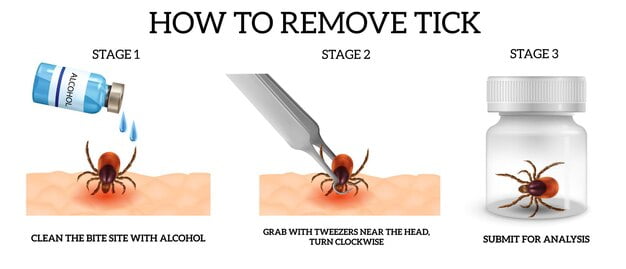How to Remove Tick from Dog: Step-by-Step Guide

The dangers of ticks for dogs
Ticks are not only a nuisance but also pose serious health risks to our furry friends. These tiny arachnids can transmit various diseases, such as Lyme disease and Rocky Mountain spotted fever, to dogs. It is crucial to understand the dangers associated with ticks and take proactive measures to protect our pets.
Ticks are commonly found in wooded areas, tall grasses, and even in our own backyards. They latch onto dogs as they pass by, attaching themselves to their skin and feeding on their blood. This can lead to discomfort, irritation, and in some cases, severe illness. It is essential to regularly check your dog for ticks and promptly remove them to prevent any potential harm.
Identifying ticks on your dog
Ticks can be difficult to spot on your dog’s fur, especially if they are small or hidden in hard-to-reach areas. However, it is crucial to regularly check your dog’s entire body, including their ears, paws, and underbelly, for any signs of ticks. Look for small, dark, or brownish bumps that appear swollen. Ticks can vary in size, ranging from the size of a pinhead to the size of a small grape.
If you suspect that your dog has ticks, it is important to act quickly. The longer ticks remain attached, the higher the risk of disease transmission. Be cautious when handling ticks, as they can carry infectious agents. It is advisable to wear gloves and use tweezers or a tick removal tool to avoid direct contact with the ticks.
Understanding tick-borne diseases
Tick-borne diseases are caused by various pathogens transmitted through tick bites. The most common tick-borne disease in dogs is Lyme disease, which is caused by the bacterium Borrelia burgdorferi. Other tick-borne diseases include Ehrlichiosis, Anaplasmosis, and Babesiosis. These diseases can cause symptoms such as fever, lethargy, joint pain, and loss of appetite.
If you notice any unusual symptoms in your dog after a tick bite, it is essential to consult a veterinarian promptly. Early detection and treatment can significantly improve the outcome for your dog. Your veterinarian may recommend diagnostic tests, such as blood tests, to identify the specific tick-borne disease and prescribe appropriate treatment.
Preparing for tick removal
Before attempting to remove a tick from your dog, it is important to gather the necessary tools and prepare yourself and your dog for the process. You will need a pair of fine-tipped tweezers or a tick removal tool, rubbing alcohol or antiseptic solution, and disposable gloves.
It is crucial to remain calm and composed during the tick removal process. Dogs can sense our emotions, and if they feel stressed or anxious, they may become more difficult to restrain. Create a calm environment, speak softly to your dog, and use gentle but firm restraint techniques if needed.
Step 1: Gather the necessary tools
To safely remove a tick from your dog, you will need a pair of fine-tipped tweezers or a tick removal tool. These tools are specifically designed to grasp and remove ticks without leaving any parts behind. Make sure the tweezers or tick removal tool are clean and disinfected before use.
Step 2: Calm and restrain your dog
Before attempting to remove the tick, it is essential to calm and restrain your dog. Use gentle but firm restraint techniques to prevent your dog from moving or jerking during the process. You may ask a family member or friend for assistance if needed.
Step 3: Locate the tick on your dog’s body
Carefully examine your dog’s body for the presence of ticks. Ticks tend to attach themselves to areas with less hair, such as the ears, neck, armpits, and groin. Once you locate the tick, take a deep breath and prepare for its removal.
Step 4: Remove the tick using tweezers or a tick removal tool
Using the fine-tipped tweezers or tick removal tool, grasp the tick as close to the skin as possible. Gently and steadily pull the tick straight out, making sure to avoid twisting or crushing the tick. Be patient and avoid any sudden movements that may cause the tick to break apart.
Step 5: Clean the area and disinfect the tools
After successfully removing the tick, clean the area with rubbing alcohol or an antiseptic solution. This will help prevent any potential infection. Dispose of the tick by placing it in a sealed bag or container and properly discarding it.
Remember to clean and disinfect the tweezers or tick removal tool thoroughly after use. This will ensure that they are ready for future tick removals and minimize the risk of contamination.
Step 6: Monitor your dog for any signs of infection
After tick removal, it is important to monitor your dog for any signs of infection or adverse reactions. Keep an eye on the tick bite site for redness, swelling, or discharge. If you notice any concerning symptoms, contact your veterinarian for further guidance.
Tick prevention tips for dogs
Preventing tick bites is key to keeping your dog safe and healthy. Here are some essential tick prevention tips:
- Use tick preventive products recommended by your veterinarian.
- Keep your dog’s environment clean and free of tick habitats, such as tall grasses and leaf piles.
- Limit your dog’s exposure to tick-infested areas, especially during peak tick seasons.
- Regularly groom your dog and check for ticks after outdoor activities.
- Consider vaccination options for tick-borne diseases, such as Lyme disease.
By following these preventive measures, you can significantly reduce the risk of tick bites and the associated diseases.
Conclusion
Ticks pose a significant threat to the health and well-being of our beloved dogs. It is crucial to be proactive in preventing tick bites and promptly removing any ticks that do attach to your dog. By following the step-by-step guide outlined in this article, you can safely and effectively remove ticks from your dog. Remember to consult your veterinarian if you have any concerns or if your dog exhibits any unusual symptoms after a tick bite. Together, we can ensure the safety and happiness of our furry companions.
Removing a Tick from Your Dog: FAQs
Q: How do I know if my dog has a tick?
A: Regularly check your dog’s fur, especially after walks in tick-infested areas, for small, brown, spider-like creatures attached to their skin. Common areas to check include the ears, neck, armpits, groin, and between the toes.
Q: What should I NOT do when removing a tick?
A: Avoid:
- Squeezing or crushing the tick: This can cause it to release harmful fluids back into your dog’s skin.
- Burning or using nail polish: These methods are ineffective and can injure your dog.
- Trying to pull the tick out with your fingers: This can leave the mouthparts embedded in the skin, increasing the risk of infection.
Q: What if the tick’s head breaks off during removal?
A: Don’t panic! Try to gently remove the remaining parts with tweezers. If unable, the head will likely be expelled naturally by your dog’s body over time. Monitor the area for any signs of infection and consult your veterinarian if necessary.
Q: When should I see a veterinarian after removing a tick?
- If you’re unable to remove the entire tick, including the head.
- If the bite area becomes red, swollen, or shows signs of infection (pus, fever).
- If your dog experiences any unusual symptoms like lethargy, loss of appetite, or vomiting after tick removal.
Q: How can I prevent tick infestations?
- Use a veterinarian-recommended flea and tick preventative medication year-round.
- Regularly check your dog after walks in tick-infested areas.
- Consider treating your yard with a tick control product.
Certainly! Here’s a FAQ section for the article on “How to Remove a Tick from Dog: Step-by-Step Guide”:
Q: What is the safest way to remove a tick from my dog?
A: The safest way is to use fine-tipped tweezers or a tick removal hook. Grasp the tick as close to the skin’s surface as possible and pull upward with steady, even pressure. Do not twist or jerk the tick, as this can cause parts of it to break off and remain in the skin.
Q: Should I wear gloves when removing a tick from my dog?
A: Yes, it’s advisable to wear gloves. Ticks can transmit infections to humans, and wearing gloves can help prevent disease transmission through skin contact.
Q: How should I dispose of a tick after removal?
A: Place the tick in a sealed container or ziplock bag and dispose of it. You can also flush it down the toilet. Do not crush the tick with your fingers.
Q: What should I do if the tick’s mouthparts remain in my dog’s skin after removal?
A: If the mouthparts remain, try to remove them with tweezers. If you’re unable to remove them, or if there’s excessive swelling or irritation, consult a veterinarian.
Q: How do I clean the tick bite area on my dog?
A: Clean the area with rubbing alcohol or an antiseptic. This helps prevent infection at the bite site.
Q: Can I use any tweezers to remove a tick?
A: It’s best to use fine-point tweezers specifically designed for tick removal. This helps avoid tearing the tick and spreading potential infections.
Q: What are the signs that my dog may have contracted a disease from a tick?
A: Watch for symptoms such as fever, lethargy, joint pain, or loss of appetite, and consult your veterinarian if you notice any of these signs.
Q: How can I prevent ticks on my dog?
A: Use veterinarian-recommended tick prevention products, keep your lawn trimmed, and check your dog for ticks regularly, especially after walks in wooded or grassy areas.
Related Posts
Are Dogs Allowed In CVS?
March 22, 2024• Dog
Are Dogs Allowed in Duane Reade?
March 22, 2024• Dog
Natural Dewormers for Dogs: Safe and Effective
March 15, 2024• Dog, Dog Health
How Do I Comfort My Dog After Neutering?
March 6, 2024• Dog, Dog Health
Dog Rubs Face on Carpet: A Guide to Why
March 5, 2024• Dog














